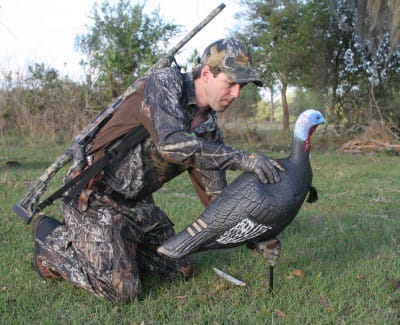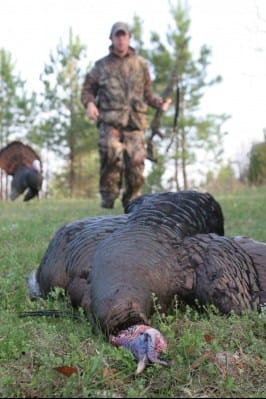
Turkey hunters have become a pretty sophisticated bunch over the last decade. Not only have they become more skilled at calling, they know more about these popular gamebirds than ever. They also know just how effective a decoy can be. But there’s more to using decoys than sticking a fake hen 30 yards in front of us and hoping it pulls a gobbler into range. In fact, 30 yards may be too far. Experienced turkey hunters have learned a trick or two about effective use of decoys.
Gobblers often hang up beyond the decoy, which is why Kansas turkey hunter Mick Bowman sets his closer. He prefers a maximum distance of about 20 yards, but he’ll often set up a decoy at 15 yards.
“You don’t want it too close. With shotgun choke tubes the way they are these days, it’s not out of the question to miss if the bird is too close. The pattern needs to open up some,” he explains.
Bowman typically carries two decoys with him: a Carry Lite Pretty Boy strutting gobbler decoy and a Pretty Girl hen. He doesn’t always use the hen, but if it’s spring and he’s chasing gobblers, Bowman will always have a gobbler decoy in front of him.
“I like to use a decoy with either a jake fan or a mature fan, depending on the situation. The adult decoy works best when there are more mature birds in the area than jakes,” he explains. “If another adult or a group of adults, particularly 2-year-olds, sees another adult gobbler in their territory, they’re going to come over and try to run him out.”
On the other hand, if Bowman is confident the area he’s hunting is loaded with jakes, he’ll swap the adult fan for a jake fan for the same reason he uses an adult fan if there are more mature toms in the area.
“Jakes tend to bunch up on an adult if they outnumber him, but an adult bird will try to jump on a single jake to show he’s the dominant one in the area,” says Bowman.
The lone gobbler set-up is ideal in the early spring when the birds are concerned more about establishing territories and dominance than actually breeding. Toms will begin to gather their harems, but prior to the peak breeding season, it’s all about fighting.
As the season progresses, however, a hen can add the extra incentive for a gobbler to make a fatal mistake. But instead of using a lone hen decoy, Bowman prefers a male-female pair. A live gobbler will see another gobbler trailing a hen and he will likely come in to investigate. Bowman will face the hen away from him and position the gobbler directly behind the hen just a foot or so. That mimics a real gobbler trailing a hen and any live gobbler might try to steal the hen away from what appears to be competition.

Some hunters prefer to face the gobbler at the hen as if he’s strutting for her. The effect on a live tom will be the same: It will instill a sense of jealousy and convince the live bird to come in for a closer look.
“I prefer to use a mature gobbler fan in that situation. It just seems to work best most of the time. However, if there are a lot of jakes in the area, I will put a jake fan on the decoy,” he says. “A mature bird will think he can run the jake off.”
Bowman won’t use a decoy on hard-hunted public land in part because of the safety factor, but mostly because real turkeys on heavily hunted land have seen every fake turkey on the market. They know the game and avoid lifeless birds at all costs.
That’s not to say safety shouldn’t be a primary concern. In fact, many hunters use “defensive” decoy set-ups if they think another hunter might be in the area. For instance, if they are setting up on a logging road, they sit off the trial and out of the line of fire in case another hunter shoots at the decoy. In other words, they consider the actions of others who may be so desperate to bag a bird, they’ll shoot before confirming their target. That may be foolish, but it’s also proof that turkey decoys are effective at fooling turkeys as well as turkey hunters.







